Haworthias are cute succulents found in many gardens and interior spaces. One thing that might strike you is the toxicity of Haworthia. Many of us have children and pets at home, so it becomes crucial to know about their toxicity.
So, in this article we shall learn, are haworthia plants poisonous or not.
In general, Haworthias are considered non-toxic for pets. However, it would be best not to let them ingest the plant because the consequences might not be pleasant. Ingestion of haworthia can upset the stomach, and the sap of this plant can also cause skin irritation and rashes.
If you grow Haworthia and have pets and children at home, this guide will give you detailed information about Haworthia toxicity and why and when they can be toxic for real.
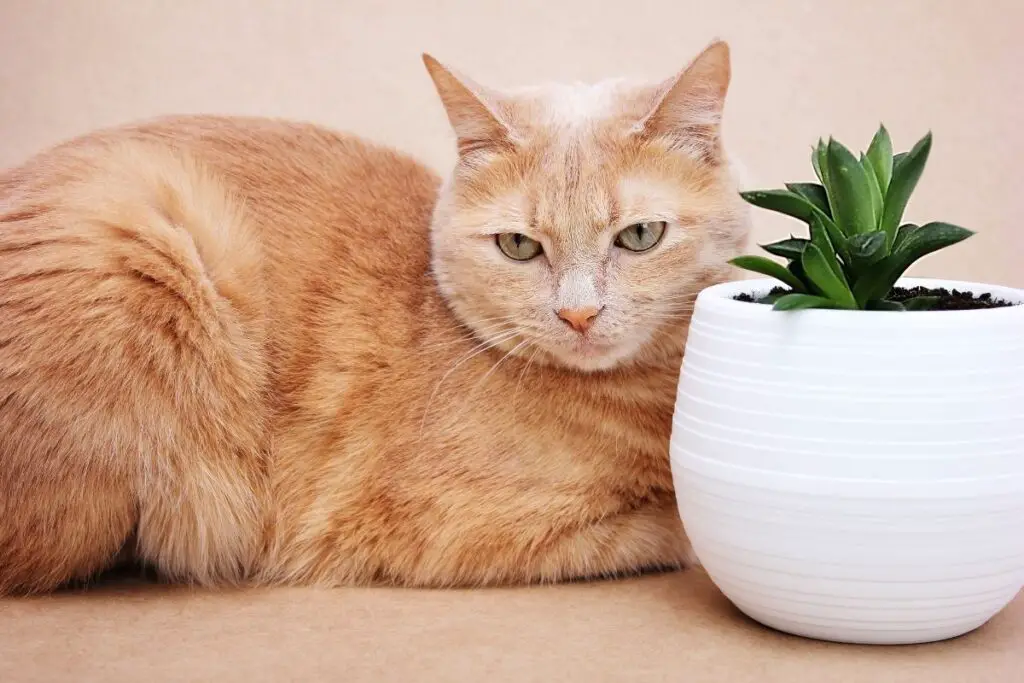
Are Haworthias poisonous or safe?
Haworthias are known for their varieties and colorful appearance, and they are also safe near animals.
Though ingesting or handling it might cause stomach issues or rashes, that won’t be dangerous or deadly.
According to the well-known American Society for the Prevention of Cruelty to Animals (ASPCA), Haworthias are documented as non-toxic plants.
Many gardeners grow Haworthia instead of Aloe Vera due to their love for the latter’s appearance.
Some Haworthia varieties look like Aloe Veras, but Aloe is toxic to pets. Therefore, people prefer the non-toxic Haworthia.
However, the sap of Haworthias can cause slight rashes when they come in contact with the skin.
It will go away after some time.
Are Haworthias poisonous to cats and dogs?
Since many people possess cats and dogs, this question is one of the most frequently asked questions.
Many people consider succulents are poisonous.
But Haworthias are not toxic to cats and dogs.
Not much will happen if they mistakenly eat it up.
Moreover, pets like cats and dogs are quite conscious about not harming their health.
They try to stay careful and sniff well before ingesting any food.
So there is less chance of them eating Haworthias.
Slight vomiting or nothing can happen.
It also depends on their health conditions.
They might feel a little uneasy due to the taste.
The problem is with the puppies and kittens.
Since they are yet to learn about being conscious about their health, they might try to taste them out of curiosity.
Are Haworthias toxic to rabbits and other small animals?
As I said earlier, no harm will happen if animals feed on them.
The same goes for small animals like rabbits.
Rabbits mostly like to munch whatever they find when hungry.
I am not sure about the results after rabbits eat them, but I am pretty sure that your garden bed will turn into a mess.
So, protect your bed with a fence barrier.
They may have a feeling of disgust due to the taste of the sap.
After that, they will never go back near them.
As I mentioned earlier, Haworthias are not considered toxic to dogs, cats, rabbits, or other living beings.
So, you don’t need to worry. If anything happens, visit a vet.
Are Haworthias poisonous to human beings?
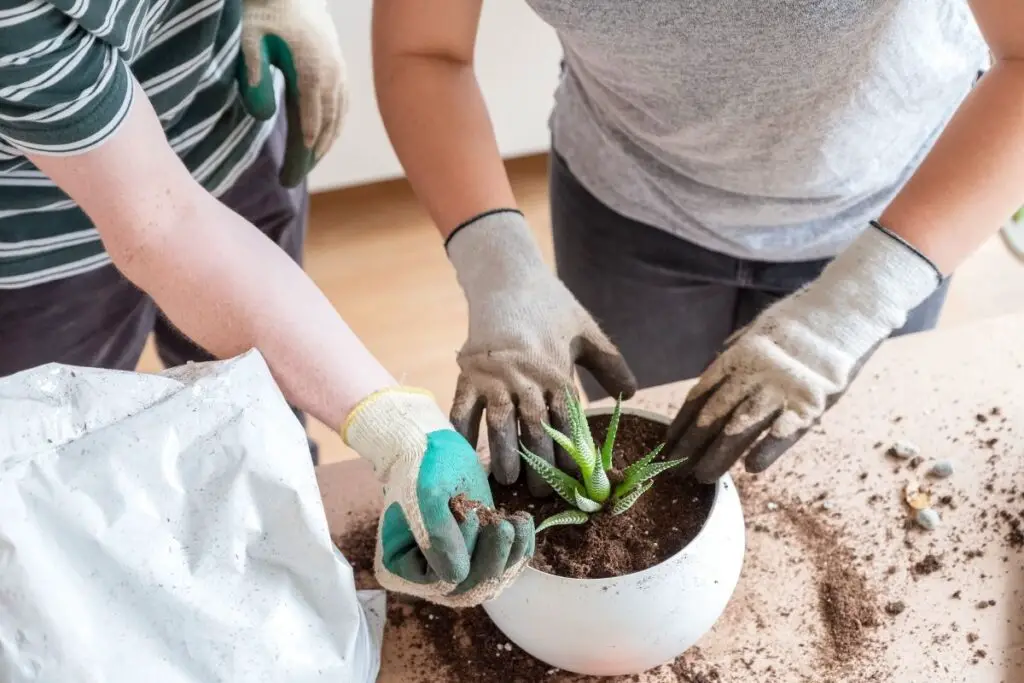
Many people claim Haworthias to be safe around both pets and humans.
However, it is better not to consume and keep them out of the children’s reach.
If Haworthias are outside, create a fence so that children won’t enter the garden.
If you have kept Haworthia indoors, make sure to keep them somewhere up where they can’t reach.
Why do people consider Haworthia to be a poisonous succulent?
Looks can be deceiving.
It is their look that makes people think of Haworthia as poisonous.
Some varieties have a fleshy look, and some have an appearance of an Aloe Vera plant.
Some plants have a rich green color with white stripes with a thorn at the leaf tip.
They all look juicy, so people might think that the leaves carry poisonous sap.
The second reason behind thinking of Haworthia as poisonous is the fact that they are succulents.
If ingested, many plants in the succulent group are poisonous and they can result in diarrhea, depression, vomiting, etc.
Since Haworthia is a succulent too, many people unknowingly consider them poisonous.
But they have been listed in the non-toxic succulent group.
They are not toxic. But still, it is suggested not to ingest them.
Looking for gardening supplies? We have tested 100's of products before recommending them to you guys. Check out our best pick below:
| Image | Gardening Supplies | Best Price? |
|---|---|---|
 Top
Top Top
Top | Raised Garden Bed Kit | Check On Amazon |
 | XLUX Soil Moisture Meter, Plant Water Monitor, Soil Hygrometer Sensor for Gardening, Farming, Indoor and Outdoor Plants, No Batteries Required | No Results |
 Top
Top Top
Top | 82 Pcs Garden Tools Set and Extra Succulent Tools Set | Check On Amazon |
 | Joeys Garden Expandable Garden Hose with 8 Function Hose Nozzle, Lightweight Anti-Kink Flexible Garden Hoses, Extra Strength Fabric with Double Latex Core, (50 FT, Black) | No Results |
 Top
Top Top
Top | Dual Chamber Compost Tumbler | Check On Amazon |
 Top
Top Top
Top | Sunnyglade Plant Stakes | Check On Amazon |
 Top
Top Top
Top | Organic Cold Pressed Neem Seed Oil | Check On Amazon |
 Top
Top Top
Top | Mighty Mint Gallon :-Insect and Pest Control Peppermint Oil | Check On Amazon |
 Top
Top Top
Top | Scotts DiseaseEx Lawn Fungicide | Check On Amazon |
 Top
Top Top
Top | Jacks Classic 20-20-20 All Purpose Fertilizer | Check On Amazon |
 Top
Top Top
Top | 30,000 Seeds Pollinator Attracting Wildflower Mixture | Check On Amazon |
 Top
Top Top
Top | Survival Vegetable Seeds Garden Kit-Over 16,000 Seeds | Check On Amazon |
What happens if your pet eats Haworthias?
In a situation where your pet has mistakenly ingested Haworthias, and their health is not well, take your pet to a vet.
There are chances that they might have consumed something else, or they ate Haworthias in large quantities.
Whatever it is, take them to the vet and confirm the problem.
They will give your pet the best treatment instead of you trying out remedies at home yourself.
What are the symptoms of Haworthia poisoning?
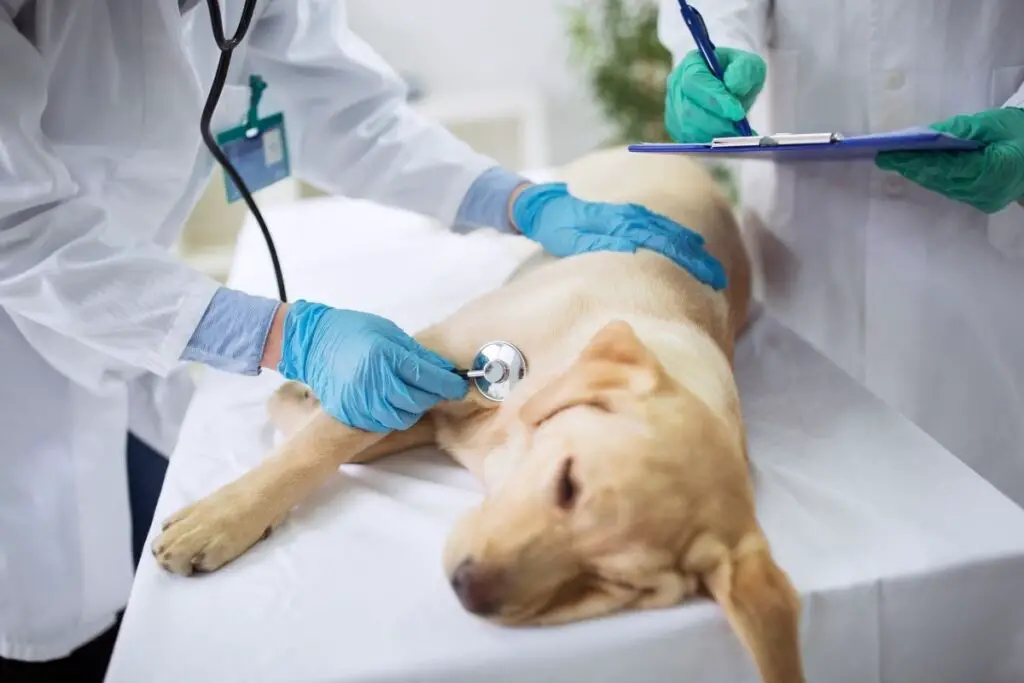
You can’t call it completely poisoning because it won’t harm you.
But the only problem could be with the sap of the leaves.
It can cause slight rashes and irritation.
But don’t worry. Wash the place, and after some time, it will go away.
Too much ingestion can result in gastrointestinal upset.
It is better to stay safe by not ingesting these succulents, be they toxic or non-toxic.
Discourage your pets from eating them.
When can Haworthias be toxic or poisonous to pets and humans?
Haworthias could be toxic when sprayed with pesticides, fungicides, or fertilizers.
When the plant suffers pest or fungus problems, we treat them with pesticides or fungicides.
During the spring and fall, most people apply fertilizers to Haworthias to boost their growth and help them grow faster.
You must ensure that no pets or children go near them for some weeks.
These sprays contain lots of chemicals that can be harmful to the health of living beings.
If your pets or children have munched a leaf, they will suffer various issues.
If you don’t want your pets or children to suffer, keep the plants out of their reach.
Consult a vet or doctor immediately for your pets and children respectively if they mistakenly ingest Haworthia leaves.
Which are some toxic succulents?
Many people grow succulents which are quite poisonous for pets and humans.
Gardeners grow these succulents beside Haworthias because they decide to keep all succulents in one place.
You must know which succulents are toxic, so your pets or children don’t go near them, and which are non-toxic so you can grow them besides Haworthias.
| Toxic succulents | Non-toxic succulents |
|---|---|
| Jade plant Aloe Vera Kalanchoes Euphorbia Cotyledon String of Pearls | Echeveria Hens and Chicks Burro’s Tail Sedums |
It is best to grow toxic and non-toxic plants separately.
Though eating non-toxic plants won’t kill living beings, it is better to keep them out of the reach of pets and children.
Why do the animals eat plants?
Many pets, especially cats and dogs, eat grasses and plant leaves. It is because:
- The plants carry vitamins and nutrients that could be missing in the pet’s diet. Haworthia and other succulents carry lots of nutrients and water in their leaves.
- It works as a laxative that helps the pets in vomiting to cure indigestion if they have had it.
- For a common reason, they are curious, anxious, or stressed.
How do I protect my pets from Haworthias and vice versa?
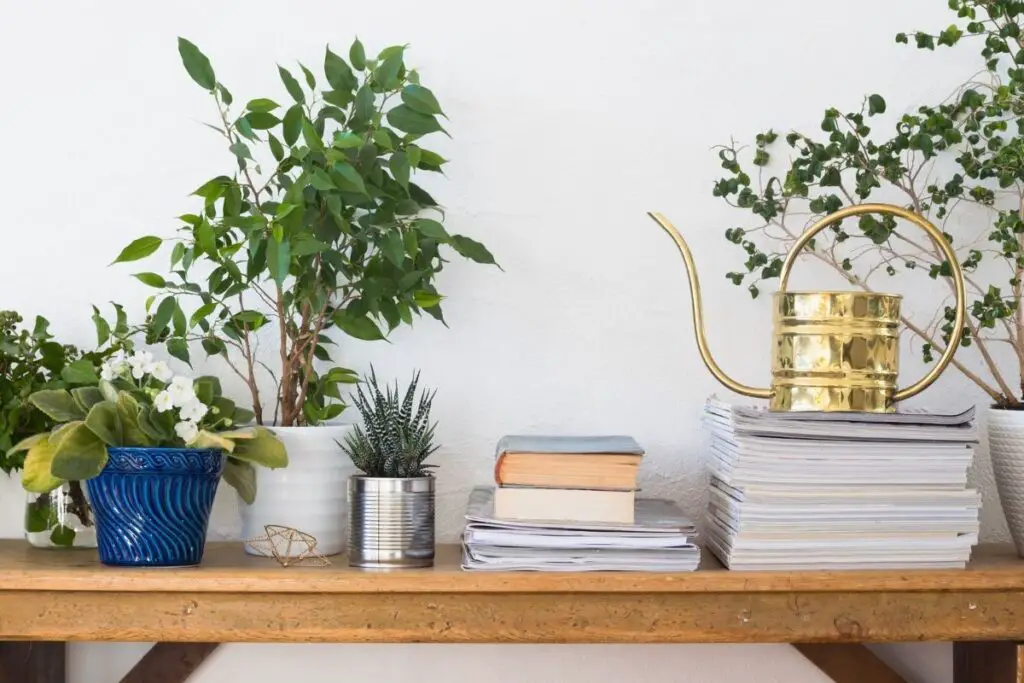
Indeed Haworthias are not toxic to any living being.
Still, protection is needed so that the plant sap doesn’t touch your skin.
Along with that, you also need to make sure that pets don’t reach your garden.
Below I have shared some points which can stop the pets from reaching your Haworthias.
It will also protect your precious plant from destruction.
Create a fence.
The first and foremost thing you must do is create a physical barrier around your garden if you have pets and children at home.
Since they are innocent and curious, you must make sure they don’t reach your garden and create a mess out of it.
It will save your garden, your children, and your pets; together at the same time.
Grow toxic and non-toxic plants separately.
Don’t keep any toxic plants near your Haworthias.
Your pet won’t know which plants are toxic and which are not.
Once they are done meddling with Haworthia, they will try to go over another one beside them.
If you grow poisonous plants, like Kalanchoes or Jade, it will badly affect your pet.
So, grow toxic plants at a separate location with a proper barrier that only you can surpass.
Or, choose a zone where the pets or children don’t visit much.
Choose a suitable location to keep your Haworthias out of the pet’s or children’s reach.
You should not choose a safe location only for toxic plants.
Select a proper site for Haworthias.
Though they are not poisonous and no harm will happen if ingested, you should not take any chance.
If your pet eats up Haworthias in large amounts, it might result in stomach or gastrointestinal upset.
That is why, either toxic or non-toxic, choose a location where the pets or your children won’t loiter much.
Choose a location where the pets can’t climb, or children can’t reach in an indoor setting.
You can also use hanging baskets, terrariums, or cages.
Use a deterrent
Deterring plants is easier for outdoors plants than indoors.
Outdoors, your garden will have a border.
You can spray some deterrent sprays, which can keep the pets away.
Citrus peels, lemon, cayenne pepper, chili pepper, and coffee grounds are some products that have such a strong odor that your pets would never loiter around your garden bed.
Some essential oils will also help, like eucalyptus, lavender, peppermint, or lemongrass.
Add ¾ parts of water in a spray and add 15 to 16 drops of the oil and spray it.
Repeat 2-3 times a month.
Aluminum foil
Tear some foils and spread them over the soil on the garden bed or containers.
You can even wrap a foil around a potted Haworthia.
Make sure that the soil in the container is slightly dry or the container is porous.
Aluminum foil can lock moisture for longer.
You can even surround your plants with pine cones.
Your pets won’t like to walk around the areas spread with such things.
Plant some strong-scented plants
Planting plants with strong scents near Haworthias can deter animals.
Plants like Sage, Rosemary, Marigold, Lavender, etc., contain a strong smell hated by most animals.
How should I protect myself while dealing with Haworthias?
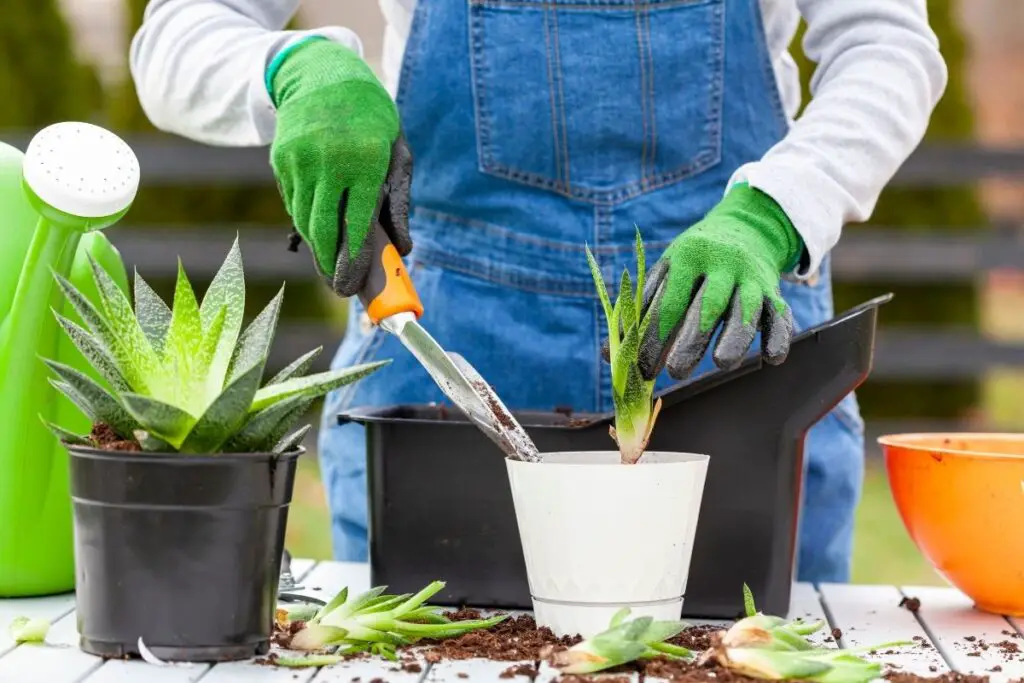
The only protection we need is for our skin.
When the sap touches our skin, it causes redness and irritation for some time.
Though it vanishes after some time, protect yourself if you don’t like it.
Wear long sleeve dress and gloves while dealing with Haworthias – spraying fertilizers, fungicides, propagating, transplanting, removing dead stuff, re-potting, etc.
Avoid loose-fitting clothes.
Wash your hand very well with soap or liquid hand wash after dealing with them.
Also, wash exposed parts of your skin that came in touch with the plant sap.
Do not burn any plant materials near your house.
The gas released might be harmful to you or the animals or other members in your house.
Always dump it in the garbage or bury it.
Final thoughts
Though Haworthias are not considered poisonous or toxic by ASPCA, you should not ingest or allow your children or pets to eat them. If consumed in large quantities, it might cause gastrointestinal upset.
Their sap may cause redness or irritation, which will heal after some time. If your skin comes in contact with its sap, wash it off immediately with soap.
Take protection while dealing with them. Follow the steps I mentioned earlier to stop the pets and children from reaching them, indoors or outdoors.
Haworthias toxicity – FAQs
Are Haworthias edible?
I am not sure whether Haworthias are edible.
Since it is not known, I suggest that you not ingest or include them in your diet.
But if eaten in large quantities, it can cause stomach upset.
Will Haworthias become toxic if grown beside other toxic plants?
Haworthias will not turn toxic if grown beside a poisonous succulent.
However, it could be dangerous for pets because after eating on Haworthias, they might try that toxic plant you are growing beside it.
So, it is better to keep the toxic plants away.
Reference: The Haworthia Society, Botanical Studies, University of Wisconsin-Madison, Sciencedirect, Researchgate, Haworthia Study.
